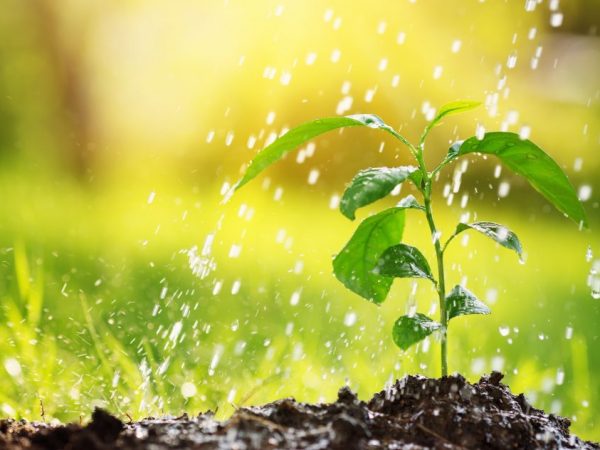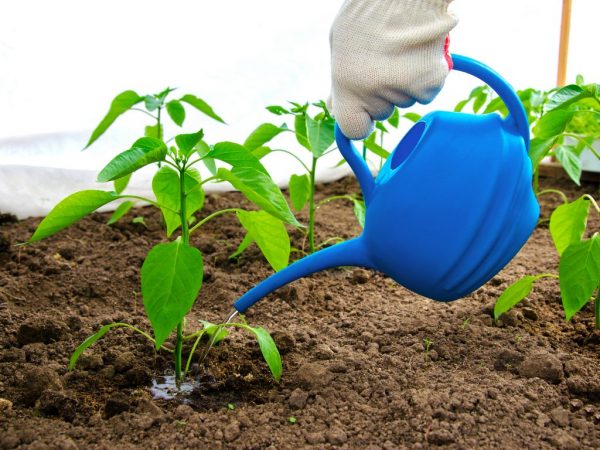How to feed pepper seedlings with hydrogen peroxide
Various methods are used to grow strong seedlings and get a good harvest. Feeding seedlings with hydrogen peroxide is one of the most interesting ways.

Top dressing of pepper with hydrogen peroxide
How hydrogen peroxide works
Before using the drug, you should study the principle of its action.
If you pour the peroxide solution over the wound, you will notice a slight hiss. This free oxygen reacts. The damaged area is disinfected, pathogenic bacteria die. The same will happen on pepper seedlings or soil.
Buying seeds from regular suppliers does not give a full guarantee of their quality. Therefore, after purchasing them, you need to sort them out, sorting out the pacifiers. Before planting seedlings, carry out a preparatory treatment of seeds with peroxide. This neutralizes the inhibitors that are under the membrane and blocks germination. After processing, the sprouts will appear much faster.
In large vegetable farms, a solution of hydrochloric acid is used. At home, for small greenhouses, it is better to use hydrogen peroxide. This is a safer method because only water will remain after the decomposition process.
Processing methods
For processing, all the seeds selected for sowing should be wrapped in a cloth and dipped in a peroxide solution so that they are completely wet and soaked.
For disinfection, you need to keep the planting material in a 10% solution for 15 minutes. To activate growth, a 10% solution is required. Soak in it for up to 12 hours. If the seeds spend more time in peroxide, they will lose their properties and become limp. After the procedure, rinse well and dry.
To strengthen immunity, it can be treated with a 1% solution from a spray bottle.
This processing technique increases the potential of seeds, disinfects them and helps prevent various diseases at all stages of development.
Soil tillage before planting seedlings
Before planting seedlings and processing it, it is necessary to disinfect the soil. Harmful insects are activated with the onset of heat. Therefore, measures for the application of peroxide to seedlings planted in untreated beds may not have the desired effect.
Open ground is processed 3-4 days before planting. For this you need 4-5 tbsp. l dilute the peroxide in 4 liters of water and water the earth. This procedure is recommended to be carried out again in the fall, after harvest.
Top dressing of seedlings
To feed the seedlings with a peroxide solution, you need to dilute 25-35 g of the substance in 1 liter of water. If you need to get a universal fertilizer, you can dilute 60 g of peroxide in 3 liters of water and water all vegetable seedlings that will grow nearby. Watering should be done often, alternating with plain water, without additives (change every 2 weeks).
- When spraying on 10 liters of water, 20 g of the solution is taken. Weak pepper seedlings will regain their strength and catch up with their fellows in their development.
- When feeding, you need the solution to be warm and penetrate into the soil by more than 15 cm.The soil should not be brought to a state of slush around the seedling holes.
- It is better to feed when there is no heat, before sunrise or after sunset. This will protect the foliage of young seedlings from burns if the solution gets on them.
Benefits of hydrogen peroxide

Watering with peroxide strengthens the root system
Watering with such a solution is of complex importance for the development of seedlings:
- strengthening the root system;
- strengthening the immunity of the aerial part;
- disinfection of the root zone and destruction of pathogenic microflora;
- improving the respiration of the plant (when spraying it acts as a source of oxygen).
Aeration of the soil enables the root system to better absorb organic and mineral fertilizers.
Watering with the addition of a medicinal solution helps to avoid late blight. For this, the following recipe is suitable:
- 1 tbsp. l. peroxide;
- 1 bucket of water (10L);
- 40 drops of iodine.
Stir all ingredients and spray over the plants. Phytoflora will die.
Prevention of diseases and pests
H2O2 can be used as a prophylactic agent against diseases and pests for seedlings and adult plants. To combat aphids, mealybugs or scale insects, the following recipe is suitable:
- 0.9 L H2O;
- 50g 3% H2O2;
- 2 tbsp. l. alcohol (90%);
- 3 drops of any dishwashing liquid.
Mix everything and pour into a spray bottle. Sprinkle on the leaves.
Due to the oxidizing properties of oxygen, hydrogen peroxide is very effective against blackleg and root rot. You need to mix 1 liter of phosphorus fertilizer with 2 tbsp. l. 3% peroxide solution and water the infected plants 2 times a week.
Before planting, transshipping pepper seedlings or diving, you need to treat the pots with this medication. This procedure will permanently get rid of root rot.
If it is possible to process the entire greenhouse, before planting the seedlings, this will prevent the appearance of all types of mold.
Contraindications
Do not use if white mold has appeared on the soil. It must be fought with other methods. Exposure to H2O2 can slow down or neutralize substances that are supposed to eradicate this disease.
There are no other contraindications. It is safe to feed and spray.
Conclusion
When growing seedlings, hydrogen peroxide is simply not replaceable for fertilizing it. It is an inexpensive and effective means of obtaining a quality crop.


